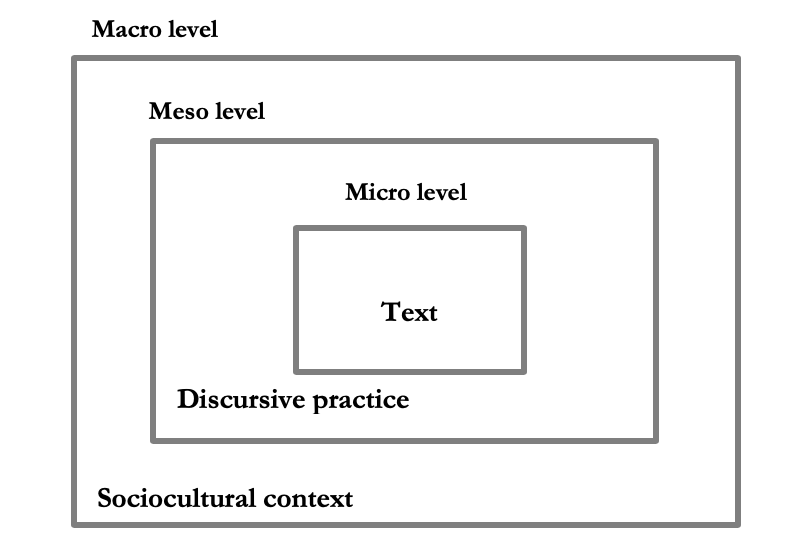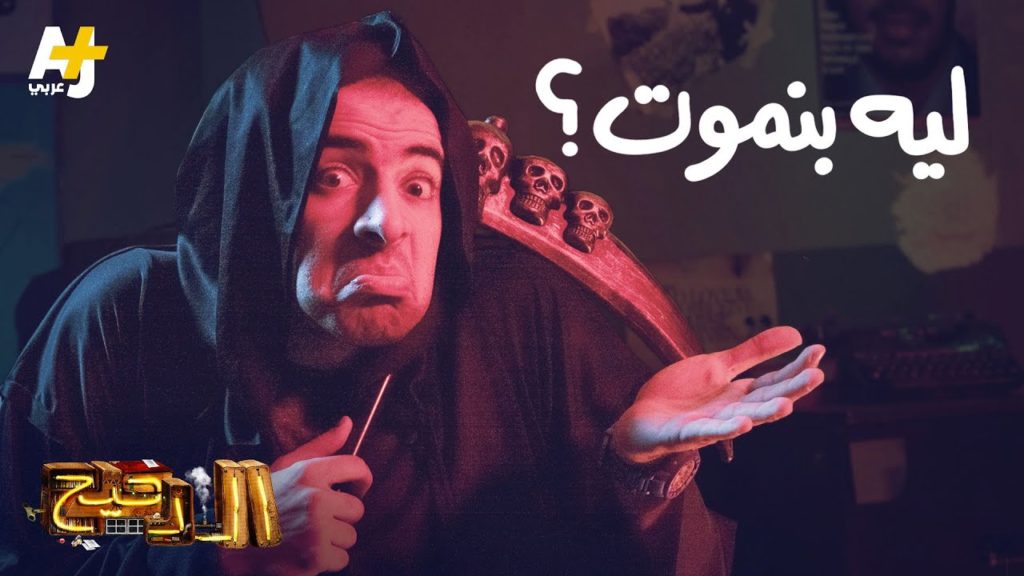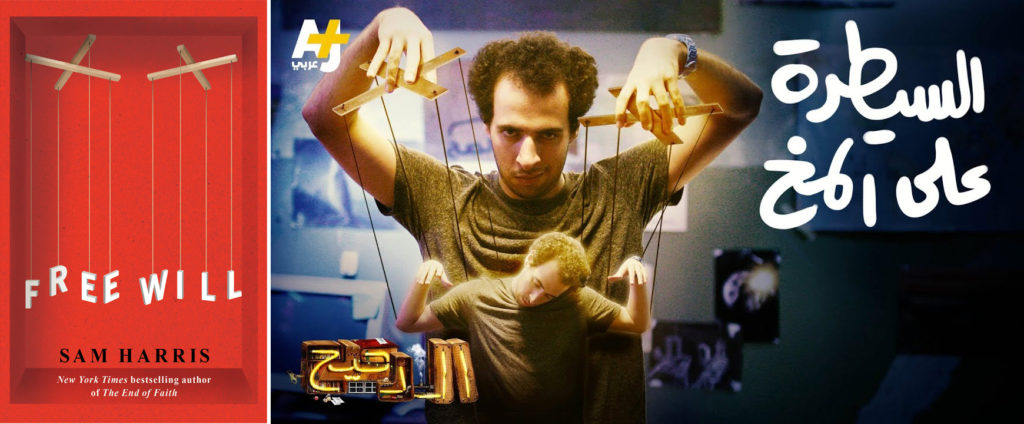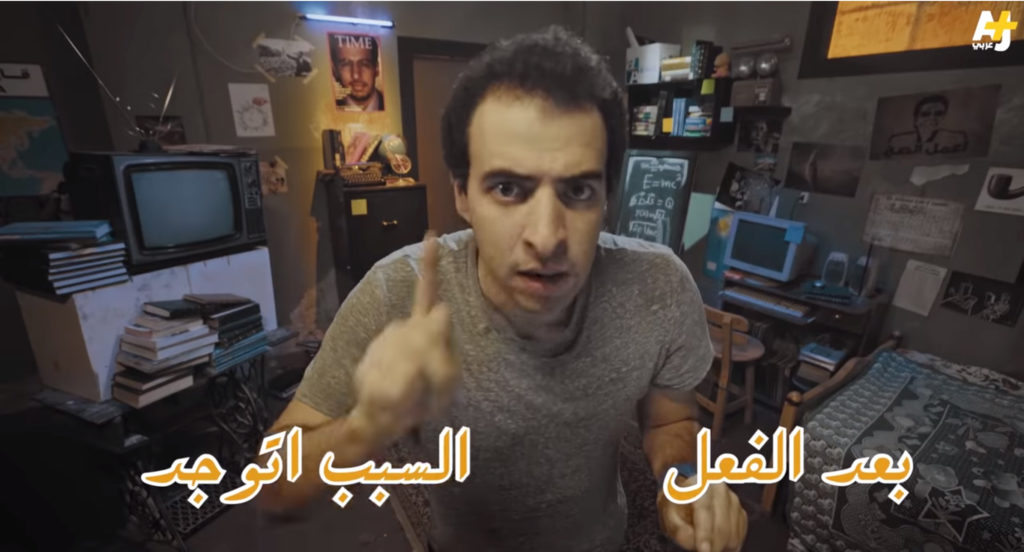Abstract
In light of the advancing digital environment and the interest in boosting scientific content published on digital platforms, this paper seeks to define and critically analyze the discourse of popular science shows (henceforth, “PSS”). Considering the fact that religion serves as a major foundational component in the Arab social and cultural context, the research focuses on the dialectic issues between science and religion with a view to determining indicators of influential and ideological hegemonic practices by PSS content creators toward viewers. Analysis is applied against the lines of Fairclough’s Critical Discourse Analysis (CDA) theory. Accordingly, this paper analyzes the three discourse dimensions adopted by the program Addaheeh (The Nerd) PSS episodes that addressed scientific issues with religious-scientific dialectics. Addaheeh is selected for being the YouTube PSS with the highest viewership and strongest influence (BBC 2019). The findings affirm that Addaheeh uses a language and discourse strategies that exercise epistemic authority on viewers; impose ideologies as manifested by several inferences, lines of reasoning and tendencies adopted by the content creator; and inculcate viewers with ideological line of Addaheeh. As per the findings, Addaheeh proceeds with a biased approach, adopting a given perspective toward religiously controversial and scientifically unsettled issues.
Introduction
Digital transformations have afforded scientific content an unprecedented pace of propagation and contributed to awareness raising of, and escalating interest in, scientific knowledge by followers (Kousha 2012). Recently, scientific institutions, such as think tanks, museums, associations, and the like, have embarked with creating a digital environment-friendly content with interaction features (Molek-Kozakowska 2018). Equally transformational presentation styles have been needed to meet the needs of various digital platform users. The real challenge is to find the right formula to transform “dry sciences” into market-driven attractive scientific content, while keeping intact the authenticity of such content. The extent of scientific content propagation is not necessarily reflective of its scientific quality or validity. There are other factors of attraction involved in propagation, including presentation, montage, filming and other technological factors shifting the nature of platforms to sophisticatedly present scientific content in a more popular way, to suit the targeted digital platform market.
Citing the ideas of atheist scientists whose output and writings have been on the rise recently (Anwar 2015), several Arabic PSSs have addressed science-religion dialectics from a purely materialistic perspective, in alignment with the Western materialistic approach. Most notable among those scientists is Richard Dawkins (2006), the author of The God Delusion, whereby he denied the existence of a god. With more than 3,000,000 copies sold worldwide, the book was a New York Times bestseller (Times 2006), and has been translated into many languages, including Arabic. Dawkins has another book of a commensurate fame, (2016), wherein he defended Darwinism from an atheist materialistic perspective. Other sources of some Arabic PSSs include writings by physicist Stephen Hawking (Hawking 2009) and Richard Dawkins (Dawkins 2016). All those sources are simplified popular science (PS) outputs intended for laypersons. Yet, the ideas and scientific hypotheses provided by those sources are based on an atheistic approach leading to anti-religion materialistic interpretation attempts of universal phenomena (Boyle 2014).
PSSs: Tracing the Contexts of Science-Religion Dialectics
Science-religion dialectics usually arise when debating whether experimental science accounts for the supernatural and existential issues of spiritualism, purpose of life, life after death, etc.; all of which are religious but non-scientifically proven issues (Dawkins 2006). This has resulted in religion-averse science that questions religious interpretations of the purpose, fact and fate of man. Such aversion is accounted for in the West by materialistic secularism and the rise against the once scientific community-dominating church in medieval Europe (Gorski 2000). Resisting that domination was supported by the emergence of Enlightenment philosophers such Auguste Comte and David Hume (Bubandt, Mikkel, and Suhr 2019). According to Comte (1858), the real understanding of the universe is attainable only through empiricism – an approach that gave way to scientism later on. In other words, what is not scientifically proven cannot be believed in. Hence, the non-experimentally proven parts of a faith would be mere metaphysical and theological spaces on which no true understanding of the universe and/or life can be based (Pickering 1993). Still with scientism, all faiths are doomed to vanish as sciences advance (Comte 1858).
As Europe managed to bring about a huge scientific renaissance that led mankind to many discoveries and scientific theories, scientists were enticed to eliminate religion and delve deeper into empiricism and scientism (Gorski 2000). However, science is yet to answer several big universal questions about the unseen and spiritual matters that have fallen beyond the grasp of human minds (Ward 2008).
In Arab societies, where religion is a key identity component as well as a major cultural and social factor (Corm 2020), addressing such dialectics in PSSs has, along with other factors, contributed to the emergence and promotion of anti-metaphysical ideas. Such ideas have evolved, both directly and indirectly, into atheistic attitudes. PSSs address such dialectics from the materialist atheist scientists’ perspectives as established by the following analysis of Addaheeh’s content. The scientists the PSS refers to offer non-Islamic materialist interpretations of supernatural and existential issues (Dowe 2005).
Western scientific citations by Arabic PSSs can be accounted for by the relative lack of Arabic scientific sources due to the unhealthy status of education and scientific research programs across Muslim and Arab societies over the last decades (Herrera 1992).
YouTube PSSs Worldwide
Relatively speaking, PSSs are not common in the Arab world (El-Awady, 2009). Reasons behind this fact include the grassroots’ lack of interest in scientific issues in general (Nasir 2018) and the lack of interest by young users to watch entertainment content over scientific research content (Clement 2019). From a global perspective, well-known YouTube PSSs have claimed millions of followers as shown in Table 1.
In the United States, TED was established in 2009 with an aim to promote scientific knowledge. Claiming sweeping fame, TED has now more than 1.5 billion followers all over the world, with contents exceeding 3,000 videos so far on various topics. Although TED is not restricted to scientific content, it has scaled up interest in science under its motto of “Ideas Worth Spreading”(TED 2006).
Other scientific channels have opted to focus singularly on scientific content, including Smarter Every Day by Destin Sandlin. Making its debut in 2007, Smarter Every Day is one of most well-known YouTube scientific channels with as much as 77 million views per one episode (Sandlin 2005). Judging by subscription and viewership rates, key YouTube scientific channels are presented below in Table 1:
Table 1 - The most viewed YouTube PSSs in 2020 [i]
| Show/Debut date | Host | Number of Subscriptions (in millions) |
| Vsauce (2010) | Michael Stevens | 15.2 |
| SciShow (2012) | Hank Green | 6 |
| Smarter Everyday (2006) | Destin Sandlin | 7.6 |
| Veritasium (2010) | Derek Muller | 6.63 |
| AsapScience (2012) | Mitchel Moffit, Gregory Brown | 8.94 |
Religion and Developing PSSs
A number of Arabic PSSs exist, however, this paper is mainly concerned with PSSs addressing religion-related concepts and doctrines, such as Al-Elm wa Al-Eman (Science and Faith), which aired its first episode in 1971. For 28 years thereafter, Al-Elm wa Al-Eman discussed scientific issues and linked them to faith. Using simple language, Al-Elm wa Al-Eman attracted high viewership rates for two reasons: (1) the simple language used in the presentations by the host, late Professor Mostafa Mahmoud; and (2) the linking of presented topics and the Creator’s omnipotence and the miraculous design of the universe (Documentary 2010). This opened appetites among the Arab population for religious-cum-scientific presentation considering the deeply rooted appreciation of religion in Arabs’ culture and social structure. But today’s different means of communication, unlimited availability of sources of knowledge and viewer-interactive media were not part of Al-Elm wa Al-Eman’s environment compared with later PSSs (Documentary 2010). In addition, Al-Elm wa Al-Eman used to receive a religious-cum-scientific TV program designation, presupposing an interest among viewers in reconciling scientific theories with inalienable religious concepts, as well as refuting atheistic, philosophic, and materialistic scientific arguments from a religious perspective.
PSSs: The Case of Addaheeh (The Nerd)
Addaheeh aired its first YouTube episode in 2014. Hosted by Ahmed Al-Ghandoor; a young Egyptian engineer. Addaheeh became the first Arabic specialist scientific-content YouTube channel (Abdelhafeiz 2016). Initially, subscribers were limited to a few hundred, and remained so for the first year. By 2016, Addaheeh boasted 100,000 subscribers (TED 2006). Afterwards, Al-Ghandoor revamped the form and content to a more professional and attractive look. By doing so, he added a dramatic dimension to his character on the show, who is described by Al-Ghandoor as insecure and narcissist; or intellectually promiscuous (TED 2006). In other words, such epithets are compelling enough for the host to glamorize his scientific knowledge in a comedic manner that masks the dry scientific content. As a matter of prologue, a comedic dramatic scene has been added to the outset of each episode.
In 2017, Addaheeh migrated to AJ+, an Al Jazeera media arm, with a professional team and production. Over 130 episodes have ensued covering various scientific topics (TED, www.ted.com, 2006), making Addaheeh second to none among Arabic PSSs with an average viewership rate of 2-3 million per episode—a number relatively unprecedented for an Arabic PSS (BBC 2019).
Alongside the rising popularity of the show, a parallel rise in controversy across social media could be witnessed, regarding the show’s episodes that cover topics intertwined with religion. While some followers accuse Addaheeh of promoting atheism, others regard it as a mere attempt at raising questions based on scientific research recapitulations. Consequently, through Critical Discourse Analysis (CDA) this paper investigates Addaheeh’s presentational attitudes and viewer-targeting impressions sought thereby among millions of followers.
Literature Review
Peer-reviewed PSS communication studies are still rare. This being the case, the researcher pursued available interdisciplinary papers on the various components of this paper, adopting Fairclough’s CDA model (1997) that has been used for many interdisciplinary studies on media, language, society, religion and politics. Along the lines of Fairclough’s model, a number of studies have been, including Manzoor, Saeed, and Panhwar (2019). Other studies addressed the importance of boosting qualitative interdisciplinary research between religion and digital media, including that of Faimau and Behrens (2019) that concluded that digital media and theology researchers need to be equipped with transdisciplinary knowledge and hard skills to enhance their interdisciplinary studies.
CDA-based studies on media content to detect hidden attitudes behind the media language used for key and sensitive social as well as religious issues include Rezaei, Kobari, and Salami (2019). This study provided an analysis of Western media discourse regarding Islam and Muslims, revealing the role played by linguistic choices and inferences in framing faith and giving a certain image thereof. Some studies revealed that Western media outlets have been using biased discourse in recent years; a discourse that presents Islam as violent and terroristic. One such study is Samaie and Malmir (2017), which clarified how Islam has been framed by means of a negative image-promoting discourse.
Also important are the studies of Ahmed and Zahoor (2020) on the media discourse toward religious minorities after 9/11; and Easteal et al. (2019) that addressed how media reports on domestic violence against women managed to attract viewers’ attention to a certain angle of a given case through linguistic tools; Xu and Tan (2020) that adopted a CDA approach to the between-the-lines messaging used by cosmetics advertisers employed to influence consumers; and Sari (2019) that used a CDA approach to the discourse of digital news platforms, concluding that discourse assumes a significant role in striking a balance between what is presented and how viewers’ attention can be attracted by means of linguistic choices and hints in headlines.
But a deeper CDA-driven insight has been used for media studies on hidden messages in presidential and leader’s speeches aired by mass media and how discourse strategies are used to affect viewers. According to Khan, Kamran and Umar (2019), the Pakistani president’s speeches on legitimizing the war on terror are found to have used an ideological discourse to win viewers over and secure public support for the state’s war on terror. More recently, a racist discourse has been used by President Trump against Muslims as concluded by Khan et al. (2019). According to the said study, Trump’s discourse on Islam and Muslims has employed linguistic strategies and citations to the effect of imposing specific self-glorification yet distorting the ideologies and image of the “Other”.
Media-propelled employment of political discourse has not been restricted to presidents. Instead, it is used by extremist groups to attain sympathy with terrorist ideas as concluded by El-Nashar and Nayef (2019). The study highlighted how ISIS uses media discourse and releases to claim support and provide a positive image for the terrorist organization.
Undoubtedly, the digital platform discourse on Islam and Muslims affects its mainstream counterpart. This holds particularly true considering the digital interactive channels made available as proven by Törnberg and Törnberg study (2016) that provided a CDA-approach to the discourse adopted by social media users on Islam and Muslims and how such negative attitudes affect those of traditional media outlets.
Studies on PSSs include Molek-Kozakowska (2018), whereby scientific journalism and climate change-related discourse was addressed. It has been found that the digital environment contributed to spreading awareness of climate change. But the question remains: how can PSSs strike the balance between attractiveness and authenticity to secure continued propagation and publishable information, respectively? Many studies question the authenticity and credibility of YouTube as a source of science-related knowledge. Hartley (2012) contends that YouTube is not a credible source of information in terms of content delivery and archiving. Rather, YouTube provides only a random and methodologically unclear designation of sciences. Consequently, YouTube should be regarded merely as a social media network, not a source of scientific knowledge. After all, YouTube has no means of reviewing its scientific content along the lines of credible academic institutions (Allgaier 2020). This finding is corroborated by Da Silva et al. (2020) as far as precise medical knowledge is concerned.
Although YouTube has brought about a breakthrough in promoting scientific content worldwide, the debate on how much scientific quality it bears and the applicable, if any, uploading standards is still ongoing. To Pariser (2011), there is a problem with Google search engine optimization (SEO) and the criteria it adopts in prioritizing search results on a given topic. Clearly, the search process is subject to unscientific criteria that lack both credibility and transparency.
Some call this non-standardized eclectic process algorithmic authority (Pariser 2011), which exercises control according to preset programming and prioritization of links and contents. As a result, this process cannot be taken as credible in terms of scientific content quality judging by the prioritized search results. Kavoori (2011) highlights a different dimension regarding the necessary differentiation between the output of well-equipped professional organizations and homemade user-generated content. YouTube has been growing as a source of scientific information for researchers despite the unmistakable need for more credible content. To Kousha (2012), there is a growing yet alarming reliance by peer-reviewed scientific journals on YouTube scientific videos as a source of information.
Research Problem
This paper seeks to detect and critically analyze Addaheeh’s discourse on scientific-religious dialectics to define the indicators of ideological hegemony exercised by the host against his viewers through inculcating certain impressions respecting the topics addressed by means of carefully chosen discourse. Such analysis is conducted through Fairclough’s (1997) CDA model that adopts a three-dimensional approach to the discourse studied. Those dimensions are (1) text, (2) discursive practice, and (3) the sociocultural context.
Research Significance
This paper derives its importance from three dimensions:
Dimension I: The multidisciplinary nature it adopts regarding science-religion dialectics on digital media in a society where religion functions as a key mainstay in its sociocultural structure.
Dimension II: The evolving ways of presenting scientific content over the last few years, particularly following the advent of social media. Addaheeh is one of the most influential PSSs in the Arab World according to Global Influence (2018).
Dimension III: Having CDA as a key tool to unveil attitudes of hosts and the sought-after impacts/impressions on viewers. This tool is applied by analyzing the discourse in its cultural, religious and social contexts.
Theoretical Framework
Critical Discourse Analysis (CDA)
This paper aims at answering the research questions through using Fairclough’s CDA model (1997) that has been used in a myriad of interdisciplinary studies on media discourse in the sociocultural context. The CDA model is an impact-communicative tool and, occasionally, a means of imposing hegemony and intellectual domination by the interlocutor over viewers.
The tool provides more in-depth analysis of content compared to other models. Meanwhile, CDA requires familiarity with, if not mastering of, the techniques of the discourse under analysis at the lexical, semantic, semiotic, and pragmatic levels, not to mention the ability to relate those levels to the sociocultural context. Accordingly, the CDA approach does not only describe what is ostensibly being said, but rather investigates the untold through established methodological tools.
Methodology
This paper is a multidisciplinary descriptive and qualitative study that uses CDA as a linguistic and sociocultural model to unveil ideological bearings of discourse. Qualitative analysis is marked with the ability to dig deeper into a phenomenon than quantitative analysis, which may not fully decipher meaning. This holds particularly true as media phenomena are extremely complex and intertwined (Bryman 2016).
Research Questions
In light of the above, this paper seeks to answer the following three questions:
- Judging by the sample episodes studied, how does the host of Addaheeh portray the science-religion relationship?
- What are the characteristics of Addaheeh content production as related to the relationship between science and religion?
- What is the governing sociocultural context of Addaheeh host’s discourse on the science-religion relationship?
Research Sample
This paper is concerned with the YouTube-based Addaheeh; the most viewed and widespread PSS at the time of conducting this study, with regular YouTube-based releases from its inception (Ahmed Al-Ghandour 2019). The episodes with religious-scientific dialectics have been analyzed. Furthermore, the researcher has comprehensively surveyed Addaheeh’s 2016-2019 episodes, reflecting the time it has been under professional AJ+ production, totaling eight episodes against the said selection standard. Those episodes are broken down in Table 2:
Table 2 - The sample episodes on religion-science dialectics under analysis
| Episode title | Airing date | Views (in millions, up to the date of this paper) | Dialectics addressed |
| Ya mahasen essodaff (What a coincidence!) | July 1, 2019 | 2.2 | The fine-tuned universe, multiple universes, the accidental universe |
| Shawarma addinasorat (Dinosaur shawarma!) | March 3, 2018 | 1.6 | Darwinism |
| Mokhayyer aw mokhayyer (Free or free!) | April 14, 2018 | 1.6 | Free will, coercion and freedom of choice, sound natural disposition |
| Alwan zaman (Old colors) | Dec. 16, 2017 | 1.5 | Evolution |
| Fadhilat al-ananiyyah (The virtue of selfishness!) | Feb. 16, 2019 | 1.8 | The selfish gene, evolution |
| Nesfak al-molhed (Your atheist half!) | July 13, 2017 | 2.9 | Free will |
| Al-baqaa (Survival) | Jan. 18, 2018 | 1 | The selfish gene, free will |
| Leeh benmoot (Why on earth we die?!) | March 30, 2019 | 3 | The selfish gene |
Analysis Tool Design
The CDA tool adopted proceeds against a three-dimensional approach to discourse. Combined, those dimensions correspond to the overall discourse ramifications at the structural and sociocultural contexts. Aligned along Fairclough’s model (1997), the researcher has divided the CDA levels of analysis into the following dimensions:

Dimension I – the linguistic level. This dimension relates to the lexical choices of the interlocution. After all, the language used expresses the host’s ideology and therefore unveils a lot about his stances toward the topics addressed and the impressions he seeks to inculcate his viewers with. This level involves several sublevels, most notably:
- The illocutionary force: This level concerns the communicative effect of an interlocutor when articulating certain lexical units to drive home a given meaning, stress a given idea or over-/underestimate a person or a thing.
- The semantic and pragmatic level: This level is concerned with clarifying the intended message of certain positive/negative linguistic structures.
- The semiotic level. This level is concerned with screenshots and messages and how they are differently received in different contexts.
Dimension II – discursive practice. This dimension relates to the characteristics and mode of producing a discourse, including how it is produced, the citations and proof involved, bringing up earlier locutions, how content is presented.
Dimension III – the sociocultural context. This dimension involves analyzing the sociocultural, and at times the political and religious contexts that govern how content is received by viewers and what impressions this content may have on them. This affects what and how the content is selected, prepared, produced, and presented.
The third (macro) level of analysis is to enable the researcher to unveil and interpret biases in the content analyzed under the second (meso) level, paving the way to tracing the motives behind lexical, pragmatic, and semiotic choices under the first (micro) level.
Findings
For purposes of applying Fairclough’s CDA model (1997) to the religion-science dialectics discussed by Addaheeh, the researcher used the aforementioned three-level tool against which the findings are presented as follows:
The Addaheeh episodes under study address religion-science dialectics with historical and philosophical origins as referred to in the literature review and methodology. Detailed premises to inferences vary as per the recurring general ideas addressed. The CDA approach used resulted in the following three issues:
- The accidental, and the start of, the universe;
- Darwinism/the selfish gene; and
- Free will/coercion and freedom.
1. How has Addaheeh Addressed the Accidental, and Start of, Universe Theories?
According to the three-level CDA tool adopted, it is found that the approach adopted by Addaheeh was not scientifically balanced. The approach failed to strike a balance between handling and proving the issues. The host adopted a multi-strategy hegemonic discourse as confirmed by the biased title of the episode in the first place. The title expressed the host’s personal attitude toward the issues addressed, not to mention certain linguistic and inference choices that would lead viewers to a certain point of view. Even if the multiverse theory is held in esteem by the scientific community, it is not the only explanation of the fine-tuned universe and physical facts. Besides, it is questions of the supernatural that incite some of the greatest controversies between atheists and followers of religion (Hawking 2009). Presented to millions of followers, the biased handling of the episode was unmistakable in its choices, which are further noted through the three levels of analysis as follows:
The macro-level: the ya mahasen essodaff (What a coincidence!) (Al-Ghandour 2019) episode sided with the accidental explanation of universe’s existence and the multiverse theory, likening it to winning a lottery in the USA. No reference to the potential existence of a creator was made in the episode. Instead, a mere attempt at a theoretical explanation was given on how the fine-tuned universe came about, using hypotheses of haphazardness and accidentality. The host cited several examples to prove how accident, even if rarely noticed, controls many parts of life. According to the host, inevitability of incidences is a fact even if pinned on rare chances.
According to Fairclough (1997), discourse is aligned along a sociocultural context in terms of production and reception. So, Addaheeh offered biased content of Western ideas that date back to a different sociocultural and religious context of the church-overwhelming power in medieval Europe (Gorski 2000). This context is different from any corresponding situation in Islam with respect to sciences—a fact condoned by Addaheeh considering the ruling out of the Islamic-Arab context and the adoption of a personal materialistic view toward the issues addressed.
Considering the religious context for which Addaheeh is produced, Islam does not reject the Big Bang theory as it was never witnessed. To Muslims, reference to the Qur’an is how one may verify a matter of al-ghayb (the Unseen) (Parsania 2006). Accordingly, the Qur’an tells us that “Surely you Lord is Allah, Who created the heavens and the earth in six days” (Ghali 2008) (Qur’an 7:54) and that the fine-tuned universe is due to “the handiwork of Allah, Who has consummated everything” (Ghali 2008) (Qur’an 27:88). Argumentation, if any, comes from scientists who totally reject the idea of a Creator, and therefore search for materialistic causes of unwitnessed universal phenomena.
The meso-level: Al-Ghandoor handled the issues of accidental existence/multiverse and the fine-tuned creation in one of the most viewed episodes, selecting a colloquial Egyptian Arabic cliché as a title to attract attention and inculcate the main idea, ya mahasen essodaff (What a coincidence!). Up to the time of writing up, the episode has received 18,000 comments, both positive and negative; reflecting how varied the viewers’ reactions have been[ii]. At the beginning of the episode, the host chose a sarcastic opening scene portraying a lottery to drive home the notion of accidental occurrence and chance-based choice by drawing scratch cards (the results of which are controlled by mere chance and randomness).

Figure 3 – The opening shot of the episode ya mahasen essodaf (What a coincidence!)
As for the discursive practice level, Addaheeh opted for a thumbnail episode-title-bearing portrait of the upcoming video to attract viewers’ attention (Figure 3 above). The message is corroborated by the host caught in action, in the middle of a random card withdrawing, to stress the idea of by-chance existence and deny—as per the multiverse theory—any omniscience behind creation.
At the level of the argumentation and citations used to argue the host’s position in the episode, Addaheeh used English terms about Western theories that explain the fine-tuning problem of the universe. It is a physical fact proven by the seamless systems of the universe, such as the unchanging speed of light, gravity, and other firmly established facts. For citations, the host cited the pro-Big Bang US physicist Fred Adams. (Al-Ghandour 2019) The host failed to cite any scientific explanation that left room for the possibility of the divine. Rather, he sufficed himself with the Western materialistic interpretation. It is likely that many viewers lack sufficient scientific knowledge to verify the host’s arguments, which are delivered humorously and with grace, leaving viewers with few unsettled questions.
The micro-level: the script used by Addaheeh in this episode was mainly oriented in skepticism. In the 16-minute episode, words with the semantic value of uncertainty and doubtfulness were heavily used detailed in Table 3:
Table 3 - Instances of words of skepticism/uncertainty, episode ya mahasen essodaf (What a coincidence!)
| Word | Instances |
| Ihtemal / yemken (may be/perhaps) | 17 |
| Sodfah (chance/coincidence) | 6 |
| Ya nassib (lottery) | 7 |
| Tawaqu’a / tanabba’a (expect/predict) | 12 |
Recurring use of such words casts doubt on all religious narratives about creation, preserving only the accidental universe theory. Additionally, bringing the lottery to a supposedly scientific issue challenges the dominant sociocultural context of the audience, as it reflects a sense of haphazardness and accidentality. Audience comments indicated that this treatment was also perceived to project those negative qualities on the Creator himself (Al-Ghandour 2019).
To leave viewers in a state of curiosity coupled with a hegemonic attitude and presumptive educational dominance judging by Fairclough’s model (1997), the host repeated clichés like “inat bass mesh wakhed balak” (it is just you who is missing something!), while delivering them in a whispering tone and a manner expressive of secret-telling. The said cliché was repeated four times to direct viewers to reconsider their previously internalized beliefs. Another recurring cliché was “fih hagat momken tekoon hassalet bemahdh essodfah elbahtah, bass nefassarha ehna ala ennaha hadith gharib wa yehtag tafseer” (stuff may have existed by mere accidence, but we usually opt for bizarre descriptions and seek supernatural explanation), much to the affirmation that the creation of this universe compels no marveling or search into the Creator because the universe may well have come into existence by mere accident.
2. Darwinism and the Selfish Gene
The discourse of this episode, after being assessed using CDA, reveals scientifically misleading and imbalanced content regarding a non-scientifically settled issue on all accounts. In particular, the religious approach contradicts the basis of Darwinism (Darwin 1909); natural selection for all creatures, including man, not to mention the evolution and reproduction of man from lower-class creatures. To Darwinists, man was not divinely created as such. The Qur’an reads, “Indeed We already created man in the fairest stature” (Ghali 2008) (Qur’an 95:4), and “So when I have molded him and breathed into him of My Spirit, then fall down to him prostrating!” (Ghali 2008) (Qur’an 38:72). The imbalance manifested itself beyond doubt at the three levels of analysis as follows:
The macro-level: Addaheeh addressed one of the major religion-science dialectics in two episodes entitled shawarma addinasorat (Dinosaur shawarma!) (Al-Ghandour 2018) and fadhilat al-ananiyyah (The virtue of selfishness) (Al-Gandour 2019). According to the analysis, the host’s approach in the abovementioned episodes focused on using biased language and citations that promote Darwinism, backed with historical accounting of supporting scientific facts. According to the analysis, the structure of discourse used proves the content creator’s familiarity with how dialectic the issue addressed is among viewers as well as the host’s choice to ignore studies ruling out the scientific reliability of Darwinism. This reflects the purposeful bias and ideology of the host and how much reliance he had on non-scientific tools to hegemonize viewers, to apply Fairclough’s (1997) rationale.
The analysis proves that the two episodes in question relied on Darwin’s On the Origin of Species (1909) and Richard Dawkins’s The Selfish Gene (2016). Such choices prove the host’s clear pro-Darwinian tendencies in light of the absence of any balance when discussing a dialectic issue that clashes with religious beliefs. Many experimental studies have found that the similarities between humans and African apes do not entail a joint origin (Johnson, 2010), much to the contrary of Darwinism. Further, man has never been proven a tailed creature, calling into question the concept of natural selection. Additionally, there are prominent Western studies refuting Darwinism with respect to the tail issue, including Belzberg (1991), Herman (2008), Turk (2016), among others. All of these studies have been published by peer-reviewed scientific journals but never cited nor referred to by the host.
The meso-level: for the shawarma addinasorat (Dinosaur shawarma!) episode, Addaheeh used semiotic tools to produce a discourse supported by archeological photos from studies and writings by evolutionists, even founded the whole episode on attempts to bridge evolutionary gaps as theorized by Darwin’s On the Origin of Species (1909). Thirteen equally biased Addaheeh-supporting links to scientific sources were left below the video.
In his leeh benmoot (Why do we die?) (2019) episode, Addaheeh used a thumbnail bearing said title (Figure 5). It is one of the three existential questions on man’s fate after this life. This title secured the highest viewing rate, hitting three million views at the time of writing. Again, Addaheeh resorted to The Selfish Gene (2016) for support; the book written by the Darwinist Richard Dawkins who is a proponent of the idea that humans live only to pass their genes on to next generations for survival. To Dawkins, humans are mere genetic vehicles and they become valueless upon passing their genes.

Figure 4 – Thumbnail for the leeh benmoot (Why do we die?) episode
Such presentation affirms the old atheist idea that man, like other animals, is a biochemical being with only slightly evolved anatomical traits and the single objective of passing human genes to offspring for survival, winnowing any higher objective in life. This falls clearly afoul of religious Qur’an-enshrined beliefs, “And in no way did I create the jinn and humankind except to worship Me” (Ghali 2008) (Qur’an 51:65). Anticipatingly, Qur’an addressed that very idea and its supporters by saying, “And they have said, ‘In no way is there anything except our present life; we die and we live, and in no way is there anything that causes us to perish except Time.’ And in no way do they have any knowledge about that; decidedly they do nothing except surmise” (Ghali 2008) (Qur’an 45:24).
The micro-level: the episode of leeh benmoot (Why do we die?) adopted a question-toned title to arouse viewers’ curiosity respecting a philosophical, religious, and existential issue. For that of shawarma addinasorat (Dinosaur shawarma!), the analysis reveals how the host intentionally chose not to mention Darwin’s book (On the Origin of Species), even adopting a sarcastic comic style saying, “elmohem sanat 1859 ahad al-ulamaa’, mane’arafsh esmah el-ha’ei’ah, nashar ketab mane’arafsh esmoh bardhoh” (the point is in 1859, a scientist, we don’t know his name for real, published a book we don’t know its name, either!).
From a pragmatic perspective, hiding the names of the book referred to and its author, not to mention the intonation of such hiding and the lack of any cover photo/author’s photo to honor the host’s presentation legacy, reflect familiarity with how controversial the issue addressed is at both the scientific and religious levels. The host used comedic language to pass such purposeful hiding.
In addition, Addaheeh adopted an indirect locutionary act to present Darwin’s own arguments to prove animal-centered evolution of man. Upon reference to Jack Horner, the scientific consultant behind Jurassic Park, the host said, “lamma ebtada yeshouf el-hagat elli esmaha atavism elli heya el-hagat elli beteb’a mestakhabiyyah fi el-hemdh ennawawi beta’ana min athar agdadna, fatlaqi mathalan atfal beyetweldo anduhum dheel” (when he started to consider atavism, that is the stuff hidden in our DNA since ancestors, like the babies born with tails). But the host failed to provide any further comment. Instead, he proceeded swiftly to the following point as if he had convinced viewers of a logical scientific argument or proof behind Darwinism. Such an attitude brings about a situation closer to induction or, at the minimum, a cognitive shock with vague spaces of religious dubiousness.
According to the analysis, Addaheeh exercised a knowledge-based power over viewers via an adamant discourse on a still much debated matter, saying: “honak itefaq min el-mogtamaa el-elmi enn dool agdad le’ashrat alaf nou’a min anwa’a ettiyoor elli mawgoodeen ennahardhah” (there is a consensus by the scientific community that those are the ancestors of ten thousand avian species in today’s world). Through this utterance the host referred to extinction-resistant dinosaurs, while citing an Archaeopteryx fossil for proof. In so doing, Addaheeh presented a photo of the fossil and talked about it for more than a minute, being the one that bridged the ancestral-to-descendant group gap according to Darwin. Moreover, the expression ‘consensus’ reveals the biased and didactic style used to achieve the hegemonic power over viewers.
Further supporting proof of the host’s ideological bias respecting natural selection theory is his discourse in the episode of Alwan zaman (Old colors) to express the evolution of the human eye by saying, “fa einak tatawaret gamed abr attareekh” (so your eyes have undergone heavy evolution over history). To the host, the human eye used to be of much less preciseness and color visual acuity. Through the dazzling and curiosity-provoking use of scientific English terms unfathomable by non-specialists, Addaheeh attracts viewers’ attention to the presenter’s passion for exploration at the expense of the subject matter addressed.
3. Free Will and Coercion
The macro-level: Addaheeh tackled ideas on coercion and free will in several episodes. The host used linguistic references and logical inferences that characterize humans as merely biochemical beings. Put differently, the tendencies, mind, and attitudes of man are determined by our genetic makeup. Accordingly, to the host, humans do not have control over their fate or decisions. Propelled by the belief that any human act and/or decision is inevitably dictated by genes, environment and physical emotions, the host was actually expressing an old philosophical idea that questions the ability of the mind to choose freely. Further, such ideology is based on purely materialistic non-religious ideas, denying any afterlife accountability, and accusing Allah (if any) of injustice should an unfree man be held accountable for acts and decisions over which one has no control.
When addressing ethics, Addaheeh created a connection between ethics and materialistic ideas, claiming that sympathy with gays or committing a crime are matters of very limited choice for man to make, since the chemical interactions and electricity in the brain may predetermine man’s disposition. Such a conclusion opens the door for questioning what reasoning, responsibility, and legislation lean against: free will. Free will is indisputably enshrined in several Qur’anic verses. To acquiesce Addaheeh’s rhetoric is to allow endless waves of questioning and skepticism with respect to divine justice. This is further clarified by examples under the following two levels of analysis of the episodes mokhayyer aw mokhayyer (Free or free!) (2018) and nesfak al-molhed (Your atheist half) (2017).
The meso-level: nesfak al-molhed (Your atheist half) received Addaheeh’s second all-time viewing rate with 2.9 million views at the time of writing. This episode was based on the idea of human dichotomy, that is, every human has two independent halves one of which is the “doer” and the other the “justifier”. That other half, according to the host, would find, or even make up, excuses. The episode starts with a questioning scene by the host saying, “kayfa bada’a al-khalq?” (how did creation start?), followed by a review of scientific experiments and studies proving the separation of action from will. The process of post-action justification away from any real free will is described next by the host, who packed the episode with supporting sources the first of which was a YouTube video by Ramachandran, the neuroscientist.
The video dates back to the 2006 Beyond Belief: Science, Religion, Reason and Survival (Ramachandran 2006)conference, which was widely attended by atheists and agnostics, most notably Sam Harris, the author of Free Will, who regards man as a biochemical will-less and choiceless puppet. Free Will (2012) is a best seller worldwide (Amazon 2012). Consequently, Addaheeh added the cover of the book for the episode “assaytarah ala el-mokh” (Controlling the Mind) (2018) (Figures 5). Several episodes also cited Richard Dawkins’ The Selfish Gene (2016). Unquestionably, those names are open about, even calling for, atheism in their writings and work.

Figure 5 - Thumbnail of the episode "assaytarah ala el-mokh" (Controlling the Mind) and the front cover of Free Will
Ramachandran’s comments regarding afterlife accountability for actions taken without free will were cited by Addaheeh, quoting the first as saying, “wa lamma Shamandran [sic] fi akher el-mohadhrah sa’al su’al wogoodi: meen fi nusseen el-mokh dol howwa el-insan dah? Erragel dah yethaseb ezzay; ala eman nussuh esshemal walla ala kufr nussuh el-yemeen?!” (Shamandran [sic] wrapped up his lecture asking an existential question: Which half of the brain does truly reflect that man? How could that man be held accountable? Is he accountable for the believing the left half [of the mind] or the disbelieving right half [of the mind]?!).
Tracing his argument to its source, it appears that Ramachandran aimed at refuting the idea of afterlife accountability because humans do not have free-will nor control over their actions. No volition, no afterlife accountability. To be objective, Addaheeh presented various scientific views and delivered the following comment regarding Ramachandran’s view, “lel’assaff el-kalam dah matnasharsh fi waraqah elmiyyah ala hassab taba’an ma dawart, fakan sa’ab bennesbali at’akked wa ashoof naqd acadeemi ala hatha el-kalam” (Regretfully, this talk was not published as a scientific paper according to my search, of course. It was hard to verify and read academic critique of that talk). However, the host continued his defense of the talk throughout the episode by quoting other scientists, while failing to refer to different views to honor the ostensible line of objectivity. In fact, this mode of argumentation and line of reasoning was relatively consistent throughout several episodes. Perhaps unsurprising given the host’s attitude and line of thought, supported with citations and scientific arguments.
The micro-level: Addaheeh used a screen script of two phrases that sum up the idea behind the nesfak al-molhed (Your Atheist Half), much to the agreement with the sought-after conclusion. This is explained by Figure 6 below.

From a pragma-semantic perspective, the locutionary (message), illocutionary (intention) and perlocutionary (effect) forces achieved here are all about establishing the lack of free will since causes precede, rather than follow, actions. The on-screen phrases intended to recap the main message of the episode, “ba’ad el-fe’al, essabab itwagad” (after actions, reasons are created), stress that idea and thus human actions are carried out without volition. Afterwards, according to Ramachandran (2006) on whose views the episode was built, one’s brain would make up a scenario to justify the action.
Additionally, using the passive form in the second phrase, ‘itwagad’ (are created), inculcates viewers with the concept those reasons do not exist in the first place, but rather are conjured up by mental processes. This is a dialectical philosophical idea on causality, which provides that each action does not necessarily require an actor because that would mean, in turn, the universe has a creator. By extension, to set causality aside means to cripple the mind as the actor builds their understandings and judgments on the action. In other words, each action has an actor; each creature has a creator. This is not a mental, but is rather a factual, judgment.
Further, it appears that the terms mind and brain have been mistakenly used interchangeably. The brain, on one hand, consists of chemistry and electricity. Both man and animals have brains with different functions and capabilities, nonetheless. The mind, on the other hand, is a prerequisite for exercising duties and rights, understanding and choosing, thought and accountability. Experimental science cannot define the realms of the mind from the materialistic perspective. The mind and the soul are non-materialistic matters with observable imprints. After all, intangibility and nonexistence are not the same thing, but are rather perceived as proof that God does exist.
Conclusion
The CDA approach applied to Addaheeh’s sample episodes has unveiled some discourse general indicators with respect to religion-science dialectics. This is further clarified below.
According to Fairclough’s multi-level CDA model, which has been adopted here as the tool of application, Addaheeh used language and discourse production strategies that ensure knowledge hegemony and specific ideological impositions on viewers as manifested by several citations, proofs, preferences, and inculcations. The host has sought to impress Arab viewers with his ideology through hegemonic discourse strategies, like those discussed by Rezaei et al. (2019).
Furthermore, the tool used herein has revealed biased handling and presentation, confirming a specific predetermined point of view with respect to religiously controversial and scientifically unsettled issues. Some such issues fall afoul of established religious beliefs. It has been found also that Addaheeh relied heavily on foreign experimental studies under the assumption of authenticity and infallibility, even building on them to reach conclusions that contradict religious texts.
It is possible that the host’s background and referential sources have not secured him sufficient religious background to address common/uncommon grounds between religion and science regarding the recurring debatable and dialectical issues. This has led him to tackle controversial yet attractive, thought-provoking and contemplatable issues. No real intention to promote atheist ideas has been detected from Addaheeh. Therefore, to simply dismiss Addaheeh as intentionally attempting to degrade established religious beliefs or promote atheist ideas is to plunge into speculation and conjecture. Unlike others, Addaheeh has not directly declared any preference toward atheism.
The research finds that Addaheeh falls short of being a source of scientific knowledge according to standards of scholarship, given the lack of oversight and review usually undergone by reliable scientific production. Further, topic choices and handling have been found to be purely personalistic and marketing-driven to ensure maximum promotion, attractiveness, and viewership. Hence, Addaheeh, regardless of viewership numbers, remains a personal (rather than institutional) effort and therefore incomparable to established scientific sources.
The research concludes also that Addaheeh has created a state of interest in and attention to scientific knowledge; a fact affirmed by episode view and comment rates. Consequently, Addaheeh can be best evaluated as a thought-and-search provoking program in the scientific fields. Science communication is as much entertaining as informational. It is different from science education in that the latter is delivered in accordance with academic courses in search of purely educational objectives.
Like any PSS, Addaheeh becomes a risk only if taken by viewers as the sole source of scientific knowledge with respect to the topics the program addresses. To quote Francis Bacon: “A little knowledge of science makes a man an atheist, but an in-depth study of science makes him a believer in God.” (Reville 2005). Ultimately, it is possible that opening a window for self-driven investigation, questioning, and research by Addaheeh may lead to misguided conclusions by the audience.
[i] The table provides the most prominent scientific YouTube channels according to viewership and subscription rates, in addition to self-designation as scientific content channels under tab About.
[ii] Addaheeh’s episodes have triggered intense debate, with many YouTube-based responses delivered by vloggers (such as Fadhel Suleiman (https://www.youtube.com/watch?v=b3nRUhxzIQI), Eyad Qenibi (https://www.youtube.com/watch?v=wFPHzM3p6jw) and Hazem Showman (https://www.youtube.com/watch?v=51_0XF88Mec). Most of those responses had refutation-like titles. Other pro-Addaheeh vloggers have been active, too (such as Ahmed Zayed (https://www.youtube.com/watch?v=8HBWPZ7JmWA)) .
 Arab Media & Society The Arab Media Hub
Arab Media & Society The Arab Media Hub




